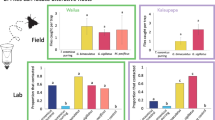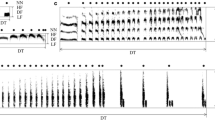Summary
Examination of three populations of the field cricket Teleogryllus oceanicus revealed the presence of an acoustically-orienting parasitoid fly, Ormia ochracea (Tachinidae), in the population of crickets that has been introduced to the Hawaiian Islands. The cricket is native to Australia and the Pacific, and the fly is native to North America but has also been introduced to Hawaii. Up to 27% of males and 7% of females in Hawaii were infested with fly larvae. Song structure in the parasitized Hawaiian population was distinct from that of the other two groups, with the Hawaiian crickets showing several reduced song parameters. In addition, onset and cessation of calling at dusk and dawn were more abrupt in the Hawaiian population. These results are consistent with selective pressure from the phonotactic flies to decrease risky calling. Silent males were present in all three populations, suggesting that these noncallers may not represent a unique adaptation to the parasitoid.
Similar content being viewed by others
References
Burk T (1982) Evolutionary significance of predation on sexually signalling males. Fl Entomol 65:90–104
Cade W (1975) Acoustically orienting parasitoids: Fly phonotaxis to cricket song. Science 190:1312–1313
Cade W (1979) The evolution of alternative male reproductive strategies in field crickets. In: Blum MS, Blum NA (eds) Sexual selection and reproductive competition in insects. Academic, New York, pp 343–379
Cade W (1981) Alternative male strategies: genetic differences in crickets. Science 212:563–564
Cade W (1984) Effects of fly parasitoids on nightly duration of calling in field crickets. Can J Zool 62:226–228
Cade W, Wyatt DR (1984) Factors affecting calling behaviour in field crickets, Teleogryllus and Gryllus (age, weight, density, and parasites). Behaviour 88:61–75
Hissman K (1990) Strategies of mate finding in the European field cricket (Gryllus campestris L.) at different population densities. Ecol Entomol 15:287–291
Hoy RR, Pollack GS, Moiseff A (1982) Species-recognition in the field cricket, Teleogryllus oceanicus: behavioral and neural mechanisms. Am Zool 22:597–607
Otte D (1992) Evolution of cricket songs. J Orthop Res 1:25–49
Otte D, Alexander RD (1983) The Australian crickets (Orthoptera: Gryllidae) (Acad Nat Sci Philadelphia Monograph 22). Allen, Lawrence
Otte D, Rice R (in press) The Hawaiian crickets. Spec Publ Acad Nat Sci Philadelphia
Pollack GS, Hoy RR (1979) Temporal pattern as a cue for species-specific calling song recognition in crickets. Science 204:429–432
Pollack GS, Hoy RR (1981) Phonotaxis to individual rhythmic components of a complex cricket calling song. J Comp Physiol 144:367–373
Pollack GS, Huber F, Weber T (1984) Frequency and temporal pattern-dependent phonotaxis of crickets (Teleogryllus oceanicus) during tethered flight and compensated walking. J Comp Physiol A 154:13–26
Robert D, Amoroso J, Hoy RR (1992) The evolutionary convergence of hearing in a parasitoid fly and its cricket host. Science 258:1135–1137
Ryan M (1985) The tungara frog: a study in sexual selection and communication. University of Chicago Press, Chicago
Ryan MJ, Rand AS (1990) The sensory basis of sexual selection for complex calls in the tungara frog, Physalaemus pustulosus (sexual selection for sensory exploitation). Evolution 44:305–314
Sabrosky CW (1953a) Taxonomy and host relations of the tribe Ormiini in the western hemisphere. Proc Entomol Soc Washington 55:167–183
Sabrosky CW (1953b) Taxonomy and host relations of the tribe Ormiini in the western hemisphere II. Proc Entomol Soc Washington 55:289–305
Sakaluk SK (1990) Sexual selection and predation: balancing reproductive and survival needs. In: Evans DL, Schmidt JO (eds) Insect defenses. SUNY, New York, pp 63–90
Simmons LW (1988) The calling song of the filed cricket, Gryllus bimaculatus (De Geer): constraints on transmission and its role in intermale competition and female choice. Anim Behav 36:380–394
Tabachnick BG, Fidell LS (1983) Using multivariate statistics. Harper and Row, New York
Walker TJ (1975) Effects of temperature on rates in poikilotherm nervous systems: evidence from the calling songs of meadow katydids (Orthoptera: Tettigoniidae: Orchelimum) and reanalysis of published data. J Comp Physiol 101:57–69
Walker TJ (1986) Monitoring the flights of field crickets (Gryllus sp.) and a tachinid fly (Euphasiopteryx ochracea) in north Florida. Fl Entomol 69:678–685
Walker TJ (1993) Phonotaxis in female Ormia ochracea (Diptera: Tachinidae), a parasitoid of field crickets. J Insect Behav 6:389–410
Walker TJ, Wineriter SA (1991) Hosts of a phonotactic parasitoid and levels of parasitism (Diptera: Tachinidae: Ormia ochracea). Fl Entomol 74:554–559
Author information
Authors and Affiliations
Additional information
Correspondence to: M. Zuk
Rights and permissions
About this article
Cite this article
Zukl, M., Simmons, L.W. & Cupp, L. Calling characteristics of parasitized and unparasitized populations of the field cricket Teleogryllus oceanicus . Behav Ecol Sociobiol 33, 339–343 (1993). https://doi.org/10.1007/BF00172933
Received:
Accepted:
Issue Date:
DOI: https://doi.org/10.1007/BF00172933




